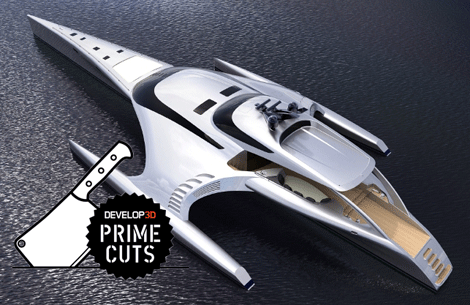
Yesterday saw the launch of the $15 million, 42-metre luxury trimaran yacht Adastra, which we featured in DEVELOP3D in August 2011.
Making its debut in some decidedly dirty water, the beautifully efficient design drew an impressive local crowd and some headlines in the world’s press.
Despite its expense and looks, the craft is incredibly economical, with its 1150hp Caterpillar C18 engine and two Yanmar 110hp outrigger engines, it has a range 4000 nautical miles at 17 knots.
Read our interview with its designer John Shuttleworth after the jump.
Looking like something normally assigned the tag ‘concept idea’, this 42.5m trimaran with more than a hint of sci-fi spacecraft about it, is currently being built in China for a very lucky (and we assume
rather wealthy) owner.
The result of more than five years of design, it is the outstanding work of Sussex-based John Shuttleworth Yacht Designs.
“The challenge of turning this concept into a viable luxury yacht has led us to further research and to develop new thinking on stability and comfort at sea for this type of craft,” explains owner John Shuttleworth.
“We have undertaken a state-of-the-art structural analysis of all the major components in the yacht in order to achieve the light weight required for very low fuel consumption. This has resulted in a exceptional vessel that is nearing completion in China.”
The Adastra offers comfortable accommodation for nine guests and up to six crew members. Almost every part of the craft is custom built: the superstructure is carbon fibre with Nomex honeycomb core, the hull is a glass and kevlar foam sandwich and the interior features oak cabinetry using honeycomb panels. Carbon fibre hatches, portlights, ladders and even hinges, are all built specifically for the vessel.
Siemens NX design software was used throughout the whole design process, including conceptual design, hull fairing and detailing, structural design, interior design and superstructure and deck gear design and detailing.
Working in 3D allowed Shuttleworth to integrate all the different phases of the design process, from conceptual design to detail drafting. It also enabled the designers to model the complex free-form surface shapes that characterise the deck superstructures, as well as more prismatic engineering forms such as structural components and deck gear.
With a maximum speed of 22.5 knots and a range of 4,000 miles at 17 knots, this multi-hulled monster is using structural design technology and aerodynamics to create the future of luxurious long range cruising.






